Tarakeshwara Temple, Hangal
The Tarakeshwara or Tarakeshvara Temple is a Hindu temple complex dedicated to Shiva as Tarakeswara located in Hangal, Karnataka, in India. It also houses a temple to Shiva's vahana, Nandi, and his son Ganesha. The complex is a listed monument of the Archaeological Survey of India. It also has three memorial stones which are sculpted with religious and military scenes and inscribed with text in the Kannada language. Its octagonal hall has a 6-metre (20 ft) diameter lotus carving as its ceiling.
| Tarakeshwara Temple | |
|---|---|
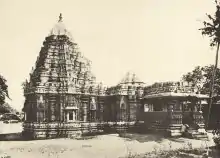 The main temple in 1897 | |
| Religion | |
| Affiliation | Hinduism |
| District | Haveri |
| Province | Karnataka |
| Deity | Shiva (as Tarakeshwara) |
| Location | |
| Location | Hangal |
| Country | India |
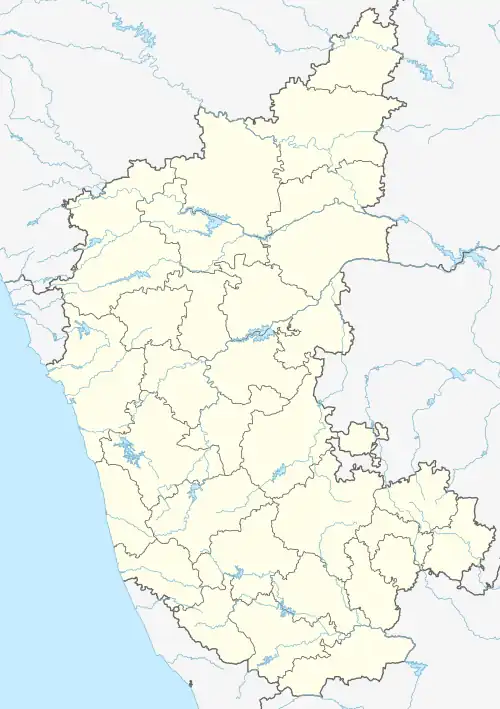 Location in Karnataka, India | |
| Geographic coordinates | 14.765°N 75.124°E |
| Architecture | |
| Completed | mid-11th or 12th century |
| Temple(s) | Two |
| Inscriptions | Memorial stones |
History
The Chalukyas of Kalyana reigned in the Deccan from the 10th to the 12th century. They built Hindu temples in Ittagi, Gadag and Lakkundi as well as in Hangal. The Tarakeshwara Temple was also built by them c. AD 1050[1] or the mid-12th century.[2]
The Tarakeshwara temple is a listed monument of the Archaeological Survey of India.[3]
Architecture
The temple is built with grey-green chloritic schist[2] in the Hoysala style.[4] More specifically, it is said to be one of the best edifices erected in the Kalyana Chalukyan style influenced by Hoysala architecture.[5]
Opposite the idol, there is an octagonal structure known as the "lotus of Hangal".[6] The elaborately-carved structure is 9 metres (30 ft) in diameter.[2][7][4][8] A huge stone, 6 metres (20 ft) in diameter, forms the ceiling of this structure. The stone, cut into the shape of a lotus, is supported by eight pillars.[6] Next to each of the eight pillars, there are sculpted stone pillars which mark the Guardians of the Directions (ashtadikpalaka).[7]
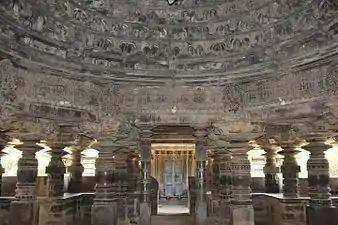 Part of the octagonal hall
Part of the octagonal hall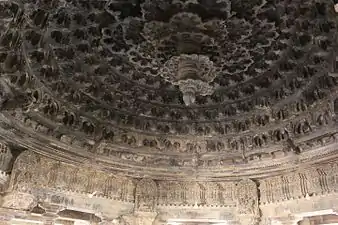 Lotus ceiling
Lotus ceiling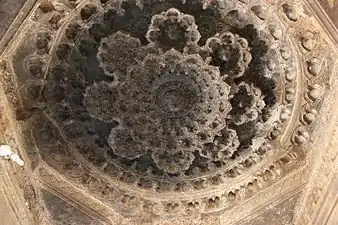 Lotus ceiling close-up
Lotus ceiling close-up
Near the main temple, there is a hall supported by 12 pillars worshipping Nandi, the bull ridden by Shiva. It and an adjacent hall are provided with an inclined balcony for sitting. The columns are made in a "lathe-turned" octagonal polished form and carved with geometric designs. The two halls are topped by stepped-pyramid roofs. The exterior walls are profusely ornamented with sculptures of miniature temples and other images.[4]
The Ganesha temple is located northeast of the main temple and oriented to the south. The temple has a "stepped plan" with a sanctum preceded by a square-shaped open hall.[1] Done in the Nagara style,[9] The tower (shikhara) is made of several miniature towers in north Indian style. The hall has a parapet with many carvings.[1]
 Exterior wall reliefs
Exterior wall reliefs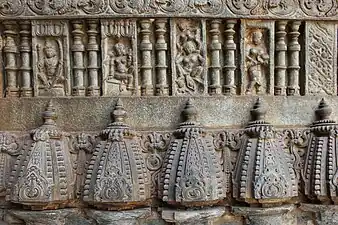 Parapet wall reliefs
Parapet wall reliefs_in_the_Tarakeshwara_temple_complex_at_Hangal.jpg.webp) Miniature towers
Miniature towers_and_Hoysala_king_Veera_Ballala_II_(c.1196)_in_the_open_mantapa_of_the_Tarakeshwara_temple_at_Hangal.JPG.webp) Three memorial stones
Three memorial stones_with_old_Kannada_inscription_at_the_Tarakeshvara_temple_at_Hangal.jpg.webp) Hero stone
Hero stone
The temple complex has three memorial stones sculpted with religious and military scenes, located in front of the halls.[2] It also has a 12th-century hero stone which shows contemporary battle weapons.[10]
References
Citations
- "General View of Small Temple North-East of the Tarakeshvara Temple, Hangal", Asia, Pacific, and Africa Collections, British Library, retrieved 22 May 2016.
- "Hungul. A temple.", Asia, Pacific, and Africa Collections, Online Gallery, British Library, retrieved 22 May 2016.
- "Dharwad Circle, Karnataka", Archaeological Survey of India, New Delhi: Ministry of Culture, 2011, retrieved 22 May 2016.
- "General View from the South-West of the Tarakeshvara Temple, Hangal", Asia, Pacific, and Africa Collections, British Library, retrieved 22 May 2016.
- Joshi (1985), p. 86.
- Edward Backhouse Eastwick (1881). Handbook of the Bombay Presidency: With an Account of Bombay City. John Murray. p. 242.
- Murray (1859), p. 417.
- "Hungul, Sculptured Memorial Stone, Hangal", Asia, Pacific, and Africa Collections, British Library, retrieved 22 May 2016.
- Kamath (1996), p. 256.
- S. K. Joshi (1985). Defence architecture in early Karnataka. Sudeep. p. xiv.
Bibliography
- Joshi, S.K. (1985), Defence Architecture in Early Karnataka, Sundeep Prakashan.
- Kamath, Suryanath U. (1996), A Handbook of Karnataka, Karnataka Gazetteer Department, Government of Karnataka.
- Murray, John (1859), A Handbook for India, Part II: Bombay.
External links
 Media related to Tarakeshwara Temple at Wikimedia Commons
Media related to Tarakeshwara Temple at Wikimedia Commons